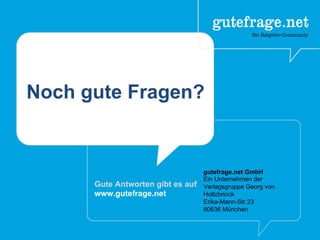Gute Produkte fallen nicht vom Himmel. Wo kommen sie dann her?
- 1. Gute Produkte fallen nicht vom Himmel. Woher kommen sie dann? Nürnberg | 26. Juni 2013
- 2. Robert Misch Agile & Lean Coach
- 4. Story
- 6. Krea+vität
- 7. Zeit
- 8. 5 Schri9e
- 10. Story
- 11. Fokus
- 12. Stories
- 13. Wissen
- 14. ©Innova+on Games
- 16. Abbild
- 17. Interpreta+on
- 18. Walt Disney
- 19. De Bono
- 21. Story
- 22. Abwägung
- 24. What are the most important costs inherent in our business model? Which Key Resources are most expensive? Which Key Activities are most expensive? Through which Channels do our Customer Segments want to be reached? How are we reaching them now? How are our Channels integrated? Which ones work best? Which ones are most cost-efficient? How are we integrating them with customer routines? For what value are our customers really willing to pay? For what do they currently pay? How are they currently paying? How would they prefer to pay? How much does each Revenue Stream contribute to overall revenues? For whom are we creating value? Who are our most important customers? What type of relationship does each of our Customer Segments expect us to establish and maintain with them? Which ones have we established? How are they integrated with the rest of our business model? How costly are they? What value do we deliver to the customer? Which one of our customer’s problems are we helping to solve? What bundles of products and services are we offering to each Customer Segment? Which customer needs are we satisfying? What Key Activities do our Value Propositions require? Our Distribution Channels? Customer Relationships? Revenue streams? Who are our Key Partners? Who are our key suppliers? Which Key Resources are we acquiring from partners? Which Key Activities do partners perform? What Key Resources do our Value Propositions require? Our Distribution Channels? Customer Relationships? Revenue Streams? Day Month Year No. This work is licensed under the Creative Commons Attribution-Share Alike 3.0 Unported License. To view a copy of this license, visit http://creativecommons.org/licenses/by-sa/3.0/ or send a letter to Creative Commons, 171 Second Street, Suite 300, San Francisco, California, 94105, USA.
- 25. Story
- 26. klein anfangen
- 27. Experimente
- 31. Kenne deine Kunden genau Überprüfe, ob das “Problem des Kunden” gelöst werden soll Arbeite mit Hypothesen, fang “klein” an und iteriere Interpre+ere, was die Kunden dir sagen Miss den Erfolg der Produkte
- 32. Ziel: Reduk:on von Zeit und Geld zwischen „pivots“ Produkt = Experiment FortschriH = validiertes Lernen
- 33. h9p://www.bigvisible.com/2013/05/why-‐lean-‐startup-‐isnt-‐enough/ Lean Startup isn‘t enough
- 34. Noch gute Fragen? Gute Antworten gibt es auf www.gutefrage.net gutefrage.net GmbH Ein Unternehmen der Verlagsgruppe Georg von Holtzbrinck Erika-Mann-Str.23 80636 München
- 35. Robert Misch Agile & Lean Coach Robert.Misch@gutefrage.net Die Folien dieses Vortrags =indest Du ab Donnerstag, 27 Juni hier: www.speakerdeck.com/robertmisch


































